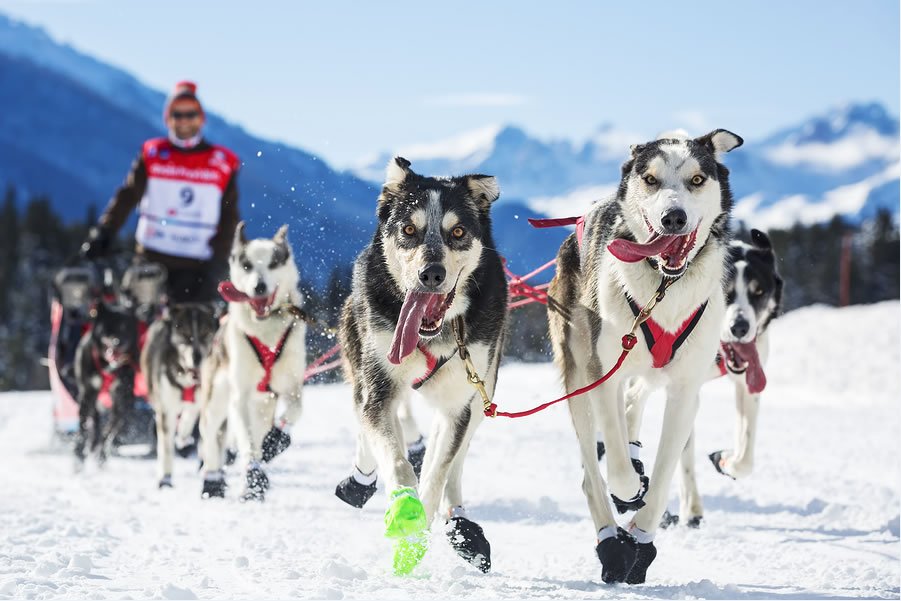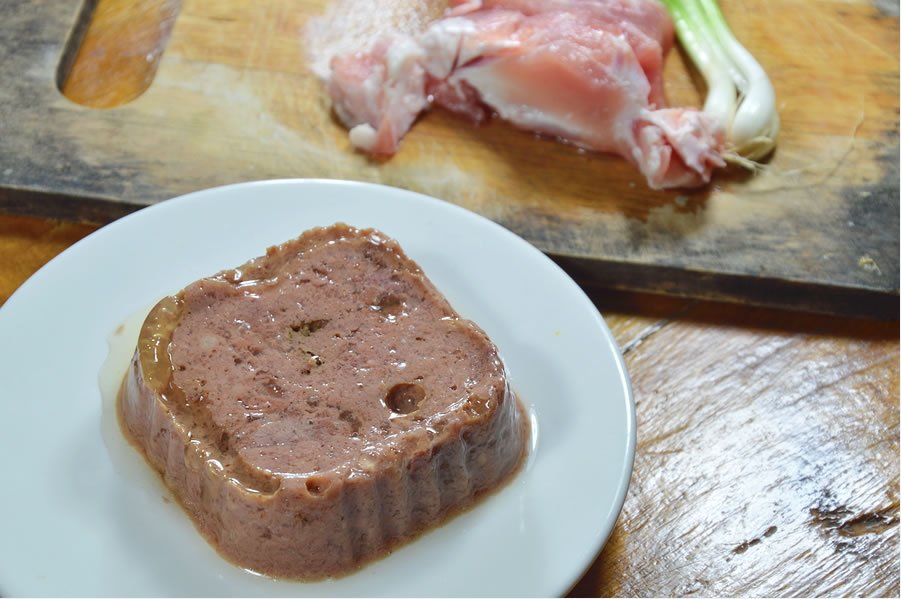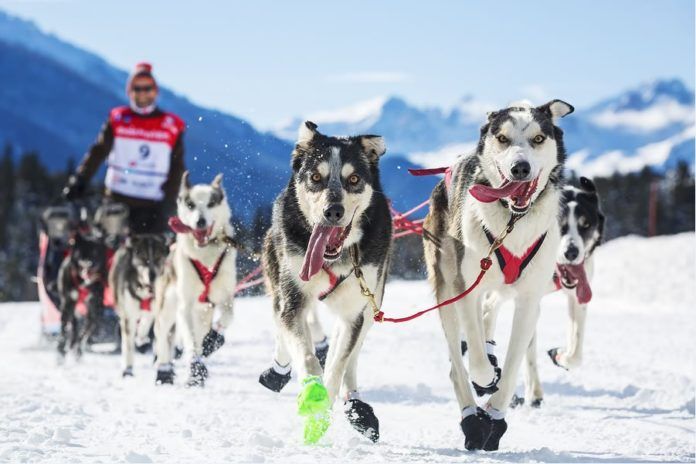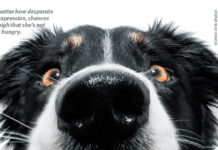

Many of the nutrition questions that come to the board-certified veterinary nutritionists on the Tufts staff come in clusters. That is, the same concerns and misconceptions have a way of recycling themselves. Herewith, some of the more common nutrition concerns people have about their dogs — and the right way to address them.
More calories in winter?
“People have said to me, ‘I want to put a few more pounds on him going into winter,'” relates Tufts veterinary nutritionist Cailin Heinze, VMD, DACVN. They think that in cold weather, dogs require more calories. Do they?
“If your dog spends a lot of time outdoors and you live somewhere that the weather turns cold in winter, then yes, they’re going to have higher calorie needs to keep warm,” Dr. Heinze says. “It takes calories to heat the body, so when the temperature gets down to freezing and lower,” more food is going to be necessary. There’s a good likelihood that a dog spending six hours a day outside in 20-degree weather will lose weight on the same number of calories he consumes when outside for six hours a day in 80-degree weather (as long as his outdoor activity level remains the same when it’s cold).
The thing is, comments Dr. Heinze, most dogs, especially in the north, live predominantly indoors, both in cold weather and warm, where the house’s furnace does the work so the body doesn’t have to. Thus, those pets are not expending extra calories to keep warm when the mercury drops. In fact, Dr. Heinze says, “a lot of dogs have decreased calorie needs in winter because their owners do not want to take them for long romps when it’s 15 degrees out. They’re not even taking hikes or long walks on weekends — most people don’t want to be outside longer than they have to be.”
The bottom line: if your dog lives mainly in the house, he doesn’t need extra calories to keep warm during the cold months. In fact, there’s a good chance he already weighs more than he needs to; somewhere between 40 and 60 percent of pet dogs are estimated to be overweight. For that reason, says Dr. Heinze, “I would discourage people putting weight on their dogs in the late fall or early winter to help them get through January, February, and March. Such dogs will come out of winter even fatter than when they went in.”
For those dogs who truly do spend a lot of winter time outdoors, exactly how much extra food to give them requires a trial-and-error approach. There are too many variables — a dog’s size, his hair coat (a husky is better prepared for being outside in cold weather than a boxer), whether the cold air is humid, how much he runs around outside — to guide people in exactly how many more calories he needs. That’s why for those dogs, it’s “really important to carefully monitor their weight and body condition and adjust food accordingly, giving more if you’re seeing consistent weight loss,” Dr. Heinze advises. (It goes without saying, she adds, that any dog who spends substantial amounts of time outdoors in any season must have appropriate shelter from the sun and weather as well as adequate water.)
“Sled dogs are probably the most obvious example” of dogs whose calorie needs change in winter. “They’re kind of the superstars of the dog athletic world,” Dr. Heinze says, “operating at a huge exercise level in truly frigid temperatures.” For them, extra calories in the cold weather is a must. “But most dogs are not like that,” she says. “They’re not entered in the Iditarod.”
What’s in a word when that word is “premium?”
In 2001, pet food labeled “premium” accounted for $5.7 billion in total pet food sales. By 2015, the amount spent on “premium” pet foods had almost tripled to $14.5 billion. Clearly, people want to do right by their dogs. But is “premium” dog food better than kibble that doesn’t have that word on the package?
“You can call anything ‘premium,'” Dr. Heinze says. “It’s a marketing term, not a term that indicates anything about a food’s quality.” Your dog’s digestive system generally can’t tell the difference. But paying more for something labeled “premium” can certainly play head games — with your head, not your dog’s.
Consider this study conducted by the California Institute of Technology and Stanford University. Volunteers were asked to sample a single wine they were told was two different wines. The difference was that in different parts of the experiment, the study subjects were told either that it cost $5 to $10 a bottle or $45 to $90 a bottle. As you might expect, they reported that the “expensive” wine tasted better. But it went beyond that. The subjects were placed in an MRI machine, and the scans actually showed enhanced activation of certain areas of their brains as the reported price of the wine went up. On a deep neurochemical level, they truly perceived that the wine tasted better when they were told it cost more.
Pet food is late to the game when it comes to what marketers term the premiumization of products. It started out in the alcohol industry, then spread to clothing, health and beauty products, and foods meant for people. Only relatively recently have dog food manufacturers gotten on the “premium” wagon train.
Don’t pay any attention to the term when choosing your dog’s food. There are no standards that need to be met other than the one advertisers set for themselves — to present a product in a way that will justify its higher cost to you than dog food not labeled premium. Yes, dog food manufacturers that market brands in the “premium” and “super-premium” categories may follow a lot of the current trends — avoidance of certain ingredients such as grains or by-products, addition of ingredients such as fruits, vegetables, or herbs, inclusion of probiotics, meat-as-the-first-ingredient, and so on. But such formulations come with no guarantee — and certainly no scientific proof — that these foods will make your dog healthier. Furthermore, the expensive ingredient they may tout — smoked salmon, or berries, for instance — may be present in truly minuscule amounts.
The bottom line: when it comes to your dog’s nutritional well-being, more expensive does not mean better for him. Don’t let the emotional impact of words without legal meanings sway your decisions.
Fitbit for Fido?
Just like the Fitbit for people to wear around their wrists, companies that manufacture products for pets are coming out with activity monitors for dogs to wear around their necks. The idea is to provide continuous monitoring of vital signs during activity for the purposes of determining whether a dog is active and fit enough, and burning enough calories.
Are they any good? “I can certainly see the appeal,” Dr. Heinze says. “I wear one [of these types of gadgets] around my own wrist.” The thing is, she says, “I don’t even know how good the data are for the ones worn by people. Sometimes the thing says I didn’t wake up at all in the night when I know I did. The technology is getting better,” but it’s not there yet. For instance, Dr. Heinze explains, “when my appliance says it’s measuring calories burned, it’s really measuring how many steps I‘m taking and then converts those to calories” based on a) how many steps it thinks I’m taking, which may or may not be accurate and b) information I input, such as my height and weight. That may not be enough to make a precise translation.
“My experience has also been that my gadget doesn’t know what to do when I ride my horse,” Dr. Heinze says. I end up with 20,000 steps taken for 20 minutes of riding I might do. I think it’s counting all four of the horse’s legs rather than gauging my activity.
Even with those issues, Dr. Heinze says, activity in people is “a little bit easier to measure than in dogs. Our bodies move once for each foot that moves,” she says. “But a dog — what is walking versus, say, rolling over?”
“I could certainly see the appeal” of a vital signs monitor for dogs, she says. “Even if they’re not entirely accurate, they spot trends and can goad you to do more to get your pet moving.” There’s just not enough science yet to show they’re close enough to the mark.
The head of the Tufts Obesity Clinic for Animals, Deborah Linder, DVM, DACVN, also has reservations. One company promises that its device has “sensor-rich” technology that “continuously monitors a range of physiological and behavioral attributes including temperature, pulse, respiration, activity positions, heart rate variability (HRV), calories and more.” But when Dr. Linder asked the company point blank if they had peer-reviewed studies to back up their claims, the answer was “not yet.”
“These products are good ideas,” Dr. Linder says. “But before you spend your money, it’s probably good to make sure there are peer-reviewed studies in reputable journals to really prove the product works. Sometimes there may be quite a few case studies written up to explain an individual pet’s experience. But what works for one bulldog might not work for many German shepherds or for your Dachshund. In an ideal world, we wait for full-scale studies with a test group, a control group, and a real study design to see if the item is accurate when compared to gold-standard equipment.
“I love the concept of being able to monitor your pet’s physiologic parameters in real time,” Dr. Linder says, “because you can learn not only about calories and fitness level but also whether the animal might be sick with a fever or some other problem. But we have to get to a point where we can trust the information.”


Does canned versus dry food ever matter?
For most dogs, it doesn’t matter whether you feed them their food from a bag or a can. Per serving, they have to meet the same standards for nutrient content, so your pet will never be shortchanged on things like protein or vitamins based on that choice. The two big differences are that canned foods are 75 to 85 percent water and are more expensive than dry kibble.
Why, then, would you ever bother to give your dog canned food, especially considering that it’s not as easy to store as dry and that some dry diets have compounds on the outside of the kibble to reduce tartar build-up on the teeth (although you should be brushing your dog’s teeth every day no matter what food you feed).
Canned foods sometimes make good options for picky eaters, smaller dogs, and those who have health problems like urinary tract issues in which increased water consumption is beneficial. They are also commonly used for dogs with dental problems such as missing teeth that may make it harder to chew dry food.
On the flip side, while all commercial dog diets have to reach specific thresholds for nutrients, canned foods are often higher in protein and fat than dry foods. That could be important for dogs who do not tolerate high-fat diets well, including those prone to pancreatitis.
By-products: hair, hooves, floor sweepings?
By-products are commonly vilified, often by manufacturers of dog foods trying to carve out market share for themselves by offering diets that do not contain them. But by-products, which are essentially organ meats and entrails, often provide more nutrients than muscle meats on a per weight basis and are important components and even delicacies of diets consumed by people in other countries. (Think sweetbreads, which are the thymus or pancreas of a cow or lamb.)
The term “by-product,” incidentally, comes from the fact that by-products are the leftovers from animal carcasses once the muscle meat (which Americans find desirable) has been removed. The definition of mammal by-products set by the Association of American Feed Control Officials specifically excludes hair, hooves, horn, hide trimmings, manure and intestinal contents, as well as anything that is not specifically part of the carcass (like floor sweepings for example).





